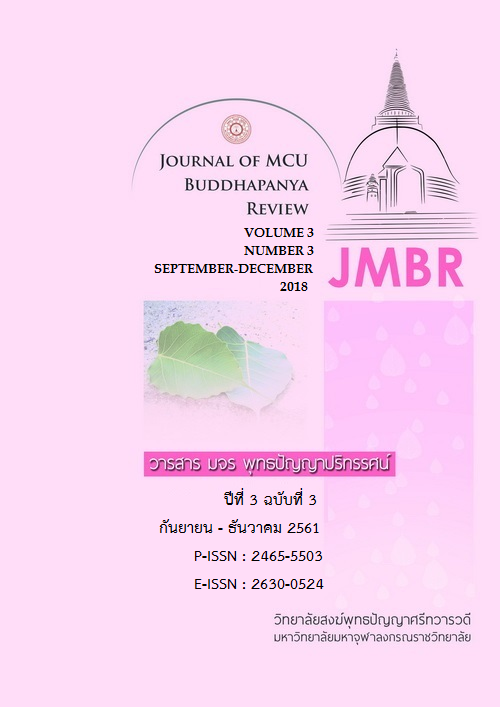ความพร้อมของครูในการจัดการเรียนการสอนเพื่อเพิ่มความสามารถในการเรียนรู้ด้วยตนเองในรายวิชาภาษาอังกฤษของนักเรียนระดับอุดมศึกษาในมหาวิทยาลัยของรัฐในภาคตะวันออกเฉียงเหนือ
คำสำคัญ:
ความพร้อมของครู, การเรียนรู้ด้วยตนเอง, ผู้เรียนที่มีความสามารถในการเรียนรู้ด้วยตนเอง, ความพร้อมของครู, การเรียนรู้ด้วยตนเอง, ผู้เรียนที่มีความสามารถในการเรียนรู้ด้วยตนเองบทคัดย่อ
งานวิจัยชิ้นนี้มีวัตถุประสงค์เพื่อศึกษาถึงความพร้อมของอาจารย์ในระดับมหาวิทยาลัยในภาคตะวันออกเฉียงเหนือของประเทศไทย ในกรณีของประเทศไทย แม้ว่าจะมีความพยายามในการพัฒนาการสอนภาษาให้สอดคล้องกับวิธีการสอนภาษาในกระแสโลก รูปแบบการเรียนรู้ด้วยตนเองจึงเป็นแนวติดที่สำคัญเนื่องจากเป็นการเน้นให้ผู้เรียนสามารถควบคุมการเรียนของตนเองได้ ซึ่งในบริบทงานวิจัยชิ้นนี้ จะเน้นถึงความสามารถในการควบคุมการเรียนรู้ทางด้านภาษาของผู้เรียนเอง เครื่องมือในงานวิจัยชิ้นนี้ได้แก่แบบสอบถามซึ่งเป็นการรวบรวมเอาแบบสอบถามต่างๆเพื่อนำมาใช้ในการสำรวจความพร้อมของครูในระดับอุดมศึกษา
ผลของงานวิจัยแสดงให้เห็นว่า ครูที่เรียนจบมาจากต่างประเทศส่วนใหญ่จะมีกรอบความคิดที่ค่อนข้างแคบและออกเชิงอนุรักษ์ในประโนเรื่องการให้โอกาสผู้เรียนในการตัดสินใจเกี่ยวับการเรียนรู้ของตน จากแบบสอบถามข้อที่ 14 ว่า “ผู้เรียนจะมีความสามารถในการเรียนรู้ด้วยตนเองมากขึ้นเมื่อผู้เรียนสามารถที่จะเลือกกิจกรรมในการเรียนรู้ได้ด้วยตนเอง” จากข้อความดังกล่าว ครูที่เรียนจบจากในประเทศระดับความเห็นด้วยอยู่ที่ (x̄ = 4.18, SD = .343) ส่วนครูที่จบจากต่างประเทศนั้นมีระดับความเห็นด้วยอยู่ที่ (x̄ = 3.43, SD = .938) อาจกล่าวได้ว่าปรสบการณ์ของครูผู้สอนเองมีผลอย่างมากในประเด็นเรื่องการเรียนรู้ด้วยตนเอง สำหรับแบบสอบถามข้อที่ 33 “ผู้ผู้เรียนภาษาที่มีแรงจูงใจมีแนวโน้มที่จะพัฒนาการเรียนรู้ด้วยตนเองมากกว่าผู้เรียนที่ไม่มีแรงจูงใจ ครูที่มีประสบการณ์ในการสอนตั้งแต่ 3-5 ปีให้ผลค่าเฉลี่ยที่ (x̄ = 3.84, SD = .973) ครูที่มีประสบการณ์ในการสอนตั้งแต่ 5-10 ปีให้ผลค่าเฉลี่ยที่ (x̄ = 4.74, SD = .446) และครูที่มีประสบการณ์ในการสอนตั้งแต่ 10-15 ปีให้ผลค่าเฉลี่ยที่ (x̄ = 4.58, SD = .572).
References
Brandl, K. (2007). Communicative Language Teaching in Action: Putting Principles to Work: Pearson/Prentice Hall.
Dam, L. (2012). Educating Students to Become Lifelong Learners. Retrieved from https://www.tesol.org/docs/default-source/new-resource-library/symposium-on-student-empowerment-8.pdf?sfvrsn=0
Dewey, J. (1938). Experience and Education. New York: Kappa Delta Pi & Touchstone.
Elizondo, L. B., & Garita, C. O. (2013). A Closer Look into Learner Autonomy in the EFL Classroom. Revista de Lenguas Modernas, 19, 325-343.
Joshi, K. R. (2011). Learner Perceptions and Teacher Beliefs about Learner Autonomy in Language Learning. Journal of NELTA, 16(1-2), 13-29.
Kohonen, V. (2007). Learning to Learn through Reflection – an Experiential Learning Perspective. In Council of Europe, Preparing Teachers to Use the European Language Portfolio – Arguments, Materials and Resources: Council of Europe Publishing. Retrieved from https://archive.ecml.at/mtp2/Elp_tt/Results/DM_layout/00_10/05/Supplementary%20text%20E.pdf.
Kolb, D. (1984). Experiential Learning: Experience as the Source of Learning and Development. Englewood Cliffs, NJ: Prentice-Hall.
Krejcie, R. V., & Morgan, D. W. (1970). Determining Sample Size for Research Activities. Educational and Psychological Measurement, 30, 607-610.
Kuptametanon, S., & Walker, K. (2016). Guidelines to Improve the Basic Education Core Curriculum. In. Retrieved from https://www.en.moe.go.th/index.php?option=com_content&view=article&id=3063:guidelines-to-improve-the-basic-education-core-curriculum&catid=1:news&Itemid=42
Little, D. (2003). Learner Autonomy and Second/Foreign Language Learning. Guide to Good Practice. Retrieved from https://www.llas.ac.uk/resources/gpg/1409#toc_0
Little, D. (2004). Constructing a Theory of Learner Autonomy: Some Steps Along the Way. In K. Mäkinen, P. Kaikkonen & V. Kohonen (Ed.), Future Perspectives in Foreign Language Education (Vol. 101, pp. 15-25). Oulu: Publications of the Faculty of Education.
Noom-Ura, S. (2013). English-teaching Problems in Thailand and Thai teachers' Professional Development Needs. English Language Teaching, 6(11), 139.
Polsaram, P. (n.d.). การปฏิรูปการเรียนการสอนระดับอุดมศึกษา: การพัฒนากระบวนการเรียนรู้ในระดับปริญญาตรีRetrieved from https://www.edu.chula.ac.th/eduinfo/ed_resch/pansak.pdf
Reinders, H. (2010). Towards a classroom pedagogy for learner autonomy: A framework of independent language learning skills. Australian Journal of Teacher Education, 35(5), 40-55.
Sapianchai, P. (2012). การบูรณาการการวิจัยและการเรียนการสอน (The Integration Between Reasearch and Teaching). Retrieved from https://www.nrct.go.th/NewsSection/tabid/78/ctl/ ArticleView/mid/388/articleId/215/-presentation--.aspx
Strong, L. (2012). A psychometric study of the teacher work-autonomy scale with a sample of U.S. teachers. (Doctoral Dissertation), Retrieved from https://preserve.lehigh.edu/ cgi/viewcontent.cgi?article=2092&context=etd
Suraratdecha, S., & Tayjasannant, C. (2016). Thai EFL teachers and learners' beliefs and readiness for autonomous learning. The Southeast Asian Journal of English Language Studies, 22(3), 153-169.
Tan, M. (2005). CLT: beliefs and practices. Journal of Language and Learning, 3(1), 104-115.
Ürün, M. F., Demir, C. E., & Akar, H. (2014). A study on ELT high school teachers’ practices to foster learner autonomy. Journal of Language Teaching and Research, 5(4), 825-836.


